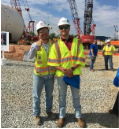How to Create a Strong Safety Culture
By: Dylan Hipple CHST, GSP

Creating a strong safety culture within a company can be one of the most difficult tasks a business sets out to do. Especially if you are taking the wrong approach. Companies that have been established for a long period of time and are looking to change their ways often run into the road block of “we’ve always done it this way” and the abundance of employees who resist any sort of change. Like with any change, this can be a slow and painful process, but in the end, everyone benefits from worker safety. There is a plethora of ways for a company to promote safety, but one of the most effective ways is through employee engagement and upper management buy-in. Outlined below are specific concepts for creating your successful safety culture.
Safety is Everyone’s Job
The first concept: safety is everyone’s job. As an employer, you must truly buy-in to the concept that safety is not a “one-man rodeo”, but in fact, everyone’s responsibility. From the CEO all the way down to the everyday laborer, the role in safety is the same. It is everyone’s job to look out for their own safety and the safety of their co-workers. At the end of the day no one wants to get hurt, no one comes into work planning on not going home or going home injured. But how do we get everyone to practice safe work concepts? From day one with a company, an employee should believe in the concept that safety is everyone’s job.
Empowering Employees
Employees should feel empowered in the concept of safety. Within a company, it is important that everyone has a voice and that each voice has a platform to be heard. By endowing employees with the responsibility of safety, they feel empowered to take action against unsafe acts and conditions. You often see companies putting a “stop work” policy in place for unsafe conditions, but who has the ability to “stop work” within that company? In a strong safety culture, every employee has the ability to stop work for any safety concern without repercussions. Rather than retribution, positive reinforcement could be used for a legitimate stop work. People strive for authority. By giving employees the power to stop work, they’ll own that responsibility with pride.
Getting Employees Engaged
Companies that have developed a strong safety culture often have a high level of employee involvement. One of the most effective ways to involve employees is by enlisting their help during the development and implementation of safe workplace practices. Workers are the ones who come in direct contact with the hazards daily, so they will often have some of the best solutions for developing safe work practices. If an employee is directly involved with the development and implementation of a safety rule or procedure, they are more likely inclined to comply with that rule. This fosters a sense of pride with the creator. At the end of the day, everyone wants to go home safe and healthy. Employees can become engaged in safety in several ways. Some of these may include safety committees, weekly safety walks, and employee safety officers.
Practicing What You Preach
Most companies today preach safety. This is usually done through a mission statement or company slogan. Often you will see phrases such as “Safety First” or “Safety is #1”, but do you really believe that is the culture? Too often companies preach safety, but do not practice “Safety First”. If you truly want to create a safety culture you must practice what you preach. If you say Safety is #1, then you must make your employees believe that. Some ways to reinforce these concepts can be accomplished through listening to employee safety concerns and taking action, enforcing stop work policies, and putting safety over production.
Ultimate Goal of Zero Incidents
No matter your level at the company you work, everyone’s goal is zero incidents. No one wants to get injured or see someone get hurt. As an employee, you must trust the concept that all incidents are preventable. At the beginning of my safety career, a mentor once told me that "all incidents are preventable". At the time I did not fully comprehend what this statement meant. When you first hear it, it sounds like a rather absurd statement. How can all incidents be preventable? What about when there is a true accident? The further I progress in my young career, the more that statement rings true. If you can get employees to fully buy-in to this concept, then you will have a successful safety program. Belief in the process, belief in the phrase “all incidents are preventable”, and believe in your employees – this will lead you to the goal of zero incidents.
Dylan Hipple CHST, GSP

